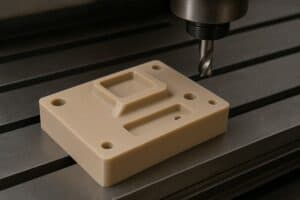
Creating precise and durable parts for prototypes or production demands materials and processes that ensure accuracy, strength, and repeatability. ABS CNC machining stands out as a solution that meets these requirements effectively. This article explores why high-quality ABS CNC machining is essential for reliable parts, the benefits it brings, and key considerations when choosing this manufacturing method.
What Makes ABS a Preferred Material for CNC Machining
ABS (Acrylonitrile Butadiene Styrene) is a widely used thermoplastic known for its toughness, impact resistance, and excellent machinability. It offers a balanced combination of strength and flexibility, making it suitable for parts that must endure physical stress while maintaining shape.
ABS plastic machines cleanly, allowing CNC tools to cut intricate designs with smooth finishes. Its resistance to heat and chemicals further enhances its appeal for prototypes and production parts in various industries, from automotive to consumer products.
ABS also has good dimensional stability. This means that parts machined from ABS maintain consistent sizes and shapes after production, reducing the risk of warping or distortion.
Understanding ABS CNC Machining
ABS CNC machining involves shaping ABS plastic material using computer-controlled cutting tools. CNC machines follow precise digital designs to cut, drill, and mill the material, creating parts with exact dimensions and detailed features.
This process is highly repeatable. Once the CNC program is set, the machine can produce multiple identical parts, which is crucial for production runs.
Because CNC machining removes material from a solid block, it allows for tight tolerances and smooth surface finishes that other manufacturing methods might struggle to achieve. This makes CNC-machined ABS parts ideal for functional prototypes and end-use components.
Benefits of High-Quality ABS CNC Machining
Precision and Accuracy
One of the most significant advantages of high-quality ABS CNC machining is the level of precision it offers. CNC machines operate with tight tolerances, often within thousandths of an inch. This accuracy ensures that parts fit perfectly with other components in assemblies.
Consistent Repeatability
For production parts, consistent quality is essential. CNC machining programs guarantee that each part is identical to the last, minimizing defects and improving overall reliability.
Fast Turnaround for Prototypes
When developing new products, quick iteration is necessary. CNC machining ABS parts allows designers to test ideas rapidly with physical models. This speed accelerates the development cycle, enabling faster improvements and adjustments.
Durability and Strength
ABS parts produced via CNC machining retain the material’s strong mechanical properties. This means prototypes and final parts can withstand everyday wear and tear, making them reliable for practical use.
Complex Geometries Made Simple
CNC machines can handle complex shapes and fine details without difficulty. This capability allows for design freedom, enabling engineers to create parts that meet specific functional requirements.
Smooth Surface Finish
The machining process leaves parts with a smooth finish, reducing the need for secondary polishing or treatments. A clean surface also improves aesthetics and functionality, especially in consumer products.
Key Applications of ABS CNC Machining
ABS CNC machining finds use in many industries, reflecting its versatility:
- Automotive: ABS parts serve in dashboards, trim components, and prototype housings due to their durability and good surface finish.
- Consumer Electronics: Cases, mounts, and internal components benefit from ABS’s stability and ease of machining.
- Medical Devices: ABS’s chemical resistance makes it suitable for various medical device housings and parts.
- Industrial Equipment: Functional prototypes and machine parts often use ABS to test designs before committing to mass production.
- Robotics and Drones: Lightweight yet strong ABS components help optimize performance.
Each application demands reliable parts that meet exact specifications, making high-quality ABS CNC machining the go-to process.
Factors to Consider for Reliable ABS CNC Machining
Material Quality
Not all ABS plastics are the same. High-grade ABS material provides better machining results, fewer defects, and improved part longevity. Always opt for trusted suppliers who offer consistent material quality.
Machine Calibration and Tooling
The precision of ABS CNC machining depends on well-calibrated machines and sharp tooling. Regular maintenance and use of proper cutting tools reduce errors and improve surface finish.
Design for Machining
Designers should consider CNC machining capabilities during the design phase. Avoiding overly thin walls or extremely tight radii improves manufacturability and reduces the risk of part failure.
Post-Processing Options
Though ABS parts often come out smooth from machining, some applications require additional finishing like painting, sanding, or vapor polishing. These steps enhance appearance and durability when needed.
Tolerance Requirements
Define acceptable tolerances clearly in the design documents. Knowing how precise the part needs to be helps machinists optimize the process and reduce unnecessary costs.
Strategic Placement of ABS CNC Machining in Manufacturing
ABS CNC machining plays a vital role especially when transitioning from prototype to production. Early-stage prototypes created with ABS CNC machining give designers a real-world feel for their parts. They can test fit, function, and aesthetics without waiting for injection molding tools.
Once the prototype is validated, the same CNC machining process can produce small to medium batches of production parts economically. This avoids upfront costs associated with molds and tooling.
In the middle of manufacturing planning, using ABS CNC machining enables businesses to respond quickly to design changes or custom orders. The flexibility of CNC machining makes it possible to adapt parts without long delays or retooling expenses.
Improving Efficiency and Quality in ABS CNC Machining
Companies achieve better results by implementing quality control measures and process optimization. Using CAD/CAM software to simulate machining paths prevents errors before production begins. This digital approach saves time and material.
Advanced CNC machines with multi-axis capabilities allow for complex geometries in fewer steps, reducing lead times. Additionally, monitoring tool wear ensures that cutters stay sharp, preventing poor finishes and dimensional inaccuracies.
Communication between designers, engineers, and machinists also plays a crucial role. Clear specifications and feedback loops reduce misunderstandings and improve the final product quality.
Environmental and Cost Considerations
ABS plastic is recyclable, and some manufacturers recycle machining scraps, reducing waste. Choosing ABS CNC machining over injection molding for low to medium quantities can lower initial investment and reduce material waste during prototyping.
While CNC machining may cost more per part in high-volume runs, it offers significant savings when producing prototypes or limited series. Businesses benefit from avoiding expensive molds and the ability to tweak designs without large financial commitments.
Conclusion
High-quality ABS CNC machining delivers precision, durability, and flexibility for producing reliable prototype and production parts. Its advantages include excellent material properties, tight tolerances, smooth finishes, and fast turnaround times. By carefully selecting materials, optimizing designs, and maintaining strict quality control, manufacturers ensure consistent, accurate parts.
ABS CNC machining supports innovation by speeding up prototyping and offering a cost-effective production solution. Its adaptability across industries makes it a valuable process for anyone needing parts that combine strength, detail, and reliability.
Investing in professional ABS CNC machining helps companies bring better products to market faster while maintaining high quality. For designers and engineers, it offers the confidence that parts will perform as expected from prototype to final production.



